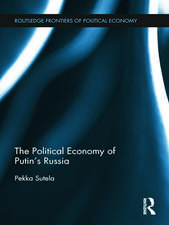Intrafamily Bargaining and Household Decisions: Microeconomic Studies
Autor Notburga Otten Limba Engleză Paperback – 17 feb 2012
Preț: 640.06 lei
Preț vechi: 753.01 lei
-15% Nou
Puncte Express: 960
Preț estimativ în valută:
122.49€ • 127.41$ • 101.12£
122.49€ • 127.41$ • 101.12£
Carte tipărită la comandă
Livrare economică 15-29 aprilie
Preluare comenzi: 021 569.72.76
Specificații
ISBN-13: 9783642457104
ISBN-10: 364245710X
Pagini: 252
Ilustrații: VIII, 242 p.
Dimensiuni: 170 x 244 x 13 mm
Greutate: 0.41 kg
Ediția:Softcover reprint of the original 1st ed. 1992
Editura: Springer Berlin, Heidelberg
Colecția Springer
Seria Microeconomic Studies
Locul publicării:Berlin, Heidelberg, Germany
ISBN-10: 364245710X
Pagini: 252
Ilustrații: VIII, 242 p.
Dimensiuni: 170 x 244 x 13 mm
Greutate: 0.41 kg
Ediția:Softcover reprint of the original 1st ed. 1992
Editura: Springer Berlin, Heidelberg
Colecția Springer
Seria Microeconomic Studies
Locul publicării:Berlin, Heidelberg, Germany
Public țintă
ResearchCuprins
1 Introduction.- 2 Models of the ‘new home economics’.- 2.1 Decisions in an existing family.- 2.2 Family formation and marital stability.- 2.3 Problems and further questions.- 3 Family decisions as a bargaining problem.- 3.1 The family as an organization of exchange.- 3.2 Household decisions as a non-cooperative game.- 3.3 Household decisions as a cooperative game.- 4 A Nash bargaining model for household decisions.- 4.1 Comparison with traditional approaches.- 4.2 Comparative statics.- 5 Time allocation in a static bargaining model with household production.- 5.1 The model.- 5.2 Division of work within the household.- 5.3 Effects of an exogenous change in wages.- 6 A dynamic model with accumulation of human capital.- 6.1 Intrafamily division of work and accumulation of human capital.- 6.2 The dynamic approach.- 6.3 Time allocation depending on individual bargaining power.- 7 Pareto efficiency of family decisions.- 7.1 Binding force of contracts and efficiency.- 7.2 Discrete choices.- 7.3 Fertility as a prisoner’s dilemma.- 8 The binding force of intrafamily contracts.- 8.1 Self-enforcing contracts.- 8.2 Enforcement by institutions.- 8.3 Remarks on policy options.- 9 Introducing uncertainty: the possibility of conflict.- 9.1 Exogenous probability of conflict.- 9.2 Causes of conflict and negotiation strategies.- 9.3 Endogenous probability of conflict.- 10 Empirical tests of the bargaining approach.- 10.1 Tests based on the Slutsky restrictions.- 10.2 Test of Pareto efficiency.- 11 Survey of empirical bargaining models.- 11.1 Household labor supply: a model with fixed bargaining power.- 11.2 Household labor supply: a game theoretic model in a discrete choice setting.- 11.3 The distribution of welfare in the household: measuring the bargaining power.- 11.4 Marriageand divorce: estimates with explicit threat point.- 12 Empirical evidence of the bargaining approach - first findings with German data.- 12.1 Balance of power within marriages.- 12.2 Fertility decision.- 12.3 Divorce behavior.- 13 Concluding remarks.

























